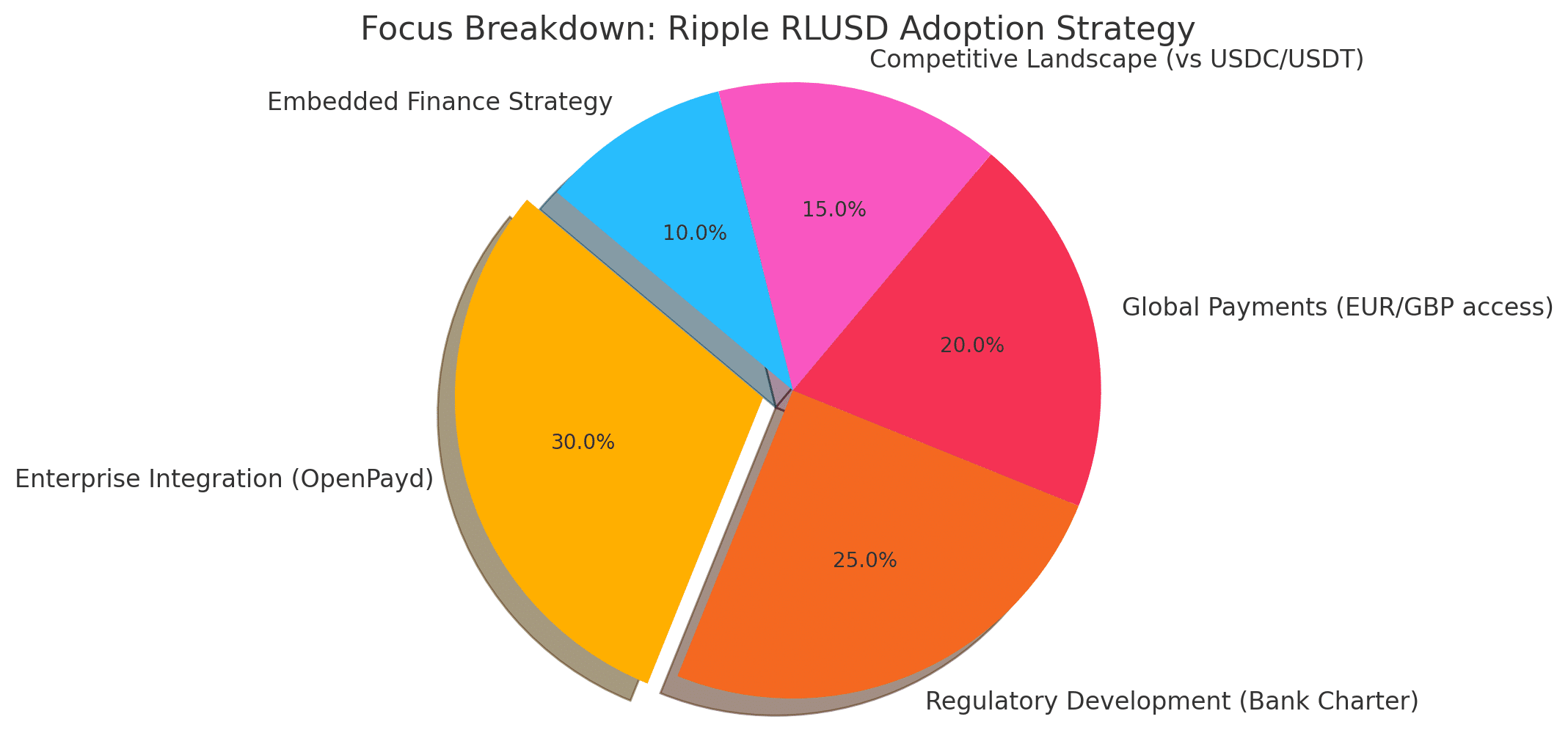Ripple’s quest to make RLUSD an enterprise-grade settlement asset moved forward this week with a broad integration of OpenPayd’s banking-as-a-service stack. The London-based provider now supplies a single API through which corporates can mint, Ripple RLUSD adoption or burn RLUSD on demand, tap real-time payouts in euros and sterling, and assign virtual IBANs to individual customers or treasury sub-accounts.
“Unified Money Movement” Meets Shrinking Friction
Jack McDonald, Ripple’s senior vice-president for stablecoins, framed the deal as a “unified money-movement layer” that merges fiat liquidity and on-chain settlement. OpenPayd CEO Iana Dimitrova echoed the theme, describing RLUSD as
“A compliant digital dollar that now behaves like native code inside every payout flow.”
The pitch resonates with multinational payroll providers, neobanks, and Web3 marketplaces—all of which struggle with slow correspondent-bank hops when moving dollars into Europe or the U.K. Embedded IBANs and instant SEPA/Faster Payments rails mean a London-based platform can hold client funds in RLUSD, pay a supplier in Madrid within seconds, and watch both sides reconcile automatically.

Ripple RLUSD Adoption: A Strategic Bid for Regulatory Credibility
Infrastructure alone is not the only goal. Ripple filed for a U.S. national bank charter and a Federal Reserve master account on July 2. The charter would let the company custody RLUSD reserves at the Fed, mirroring the model Circle is pursuing for USDC, and clear domestic wires without an intermediary bank. Market observers see that step as critical to differentiating Ripple RLUSD adoption from private-bank-sponsored rivals; holding collateral inside the Federal Reserve System neutralizes counterparty risk and, by extension, bolsters corporate treasurers’ confidence.
Regulatory momentum also favors the move. The U.S. Senate’s passage of the GENIUS Act in May laid out disclosure and audit obligations for fiat-backed stablecoins, while Dubai’s Virtual Asset Regulatory Authority granted RLUSD full approval in June. The dual-jurisdiction progress signals that regulators are increasingly willing to bless dollar tokens that keep cash and short-term Treasuries ring-fenced from operating capital.
Competitive Stakes in a Crowded Stablecoin Field
RLUSD’s market value has climbed to roughly $470 million since its October 2024 launch, an order of magnitude below USDC and far behind Tether’s USDT but sufficient to place it among the top ten fiat-backed tokens. The OpenPayd integration aims squarely at growing that footprint by removing onboarding hurdles for midsize enterprises that lack in-house blockchain teams.
OpenPayd’s client roster adds immediate distribution. The platform already services European branches of Latin American neobanks, several sports-betting operators, and a handful of U.K. payroll providers, segments that prize low-latency payments and 24-hour access to dollars. Each merchant activated on the new API can toggle between fiat and Ripple RLUSD adoption in seconds, effectively multiplying stablecoin velocity without touching a crypto exchange.

Embedded Finance as the Next Stablecoin Frontier
PYMNTS positions the Ripple-OpenPayd tie-up within a broader move toward “invisible” finance, where business users never see blockchain jargon yet reap the benefits of instant settlement and programmability. From an ecosystem standpoint, the more RLUSD flows through automated accounts-receivable dashboards or payroll engines, the stickier it becomes: treasurers hold balances for operational reasons, developers build around predictable APIs, and liquidity providers quote tighter spreads.
Meanwhile, Reuters frames Ripple RLUSD adoption and Ripple’s bank-charter gambit as a bid to leapfrog both PayPal USD and USDC on trust, arguing that direct Fed custody would make RLUSD the only major stablecoin with government-level backing for its reserves. That narrative could matter to listed companies bound by stricter counterparty-risk guidelines.
Overview
If history is a guide, the winners in stablecoins will be those that embed dollars where businesses already live, not those that wait for firms to open crypto wallets. By welding OpenPayd’s fiat plumbing to RLUSD, and pursuing a bank charter that could place reserves on the Federal Reserve’s balance sheet, Ripple RLUSD adoption is betting that compliance plus convenience will trump sheer market capitalization.
Frequently Asked Questions (FAQs)
What is RLUSD and how is Ripple using it?
RLUSD is Ripple’s U.S. dollar-backed stablecoin. It’s used for enterprise payments and now integrates with OpenPayd for direct minting and payouts.
How does the OpenPayd partnership help Ripple RLUSD adoption?
OpenPayd’s API enables businesses to mint, burn, and settle RLUSD in real time with EUR and GBP, making it easier for companies to adopt RLUSD.
Is Ripple seeking a U.S. bank license for RLUSD?
Yes, Ripple has applied for a U.S. national bank charter and a Fed master account to securely custody RLUSD reserves and build trust with institutions.
Glossary of Key Terms
Ripple RLUSD adoption
The expansion and integration of Ripple’s RLUSD stablecoin across enterprise platforms, supported by partnerships and regulatory moves
Stablecoin
A type of cryptocurrency pegged to the value of a stable asset, like the U.S. dollar, designed for low volatility and real-world payments
OpenPayd
A Banking-as-a-Service provider offering APIs for accounts, payments, and FX, now enabling embedded finance for RLUSD
Embedded finance
The integration of financial services like payments or banking directly into business platforms or software using APIs
Virtual IBAN
A digital International Bank Account Number used to receive and manage fiat payments in multi-currency accounts
Fed master account
An account with the U.S. Federal Reserve, allowing institutions to directly clear payments and custody funds without intermediaries
Mint and burn





































































































![BitTorrent [New]](https://s2.coinmarketcap.com/static/img/coins/64x64/16086.png)













